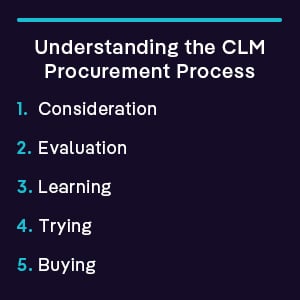With ever-increasing frequency, large- and medium-sized organizations are coming up with legal digital transformation strategies and adopting contract lifecycle management (CLM) software. This is especially true in tightly regulated industries, like pharma and medical devices, healthcare, and energy and utilities. As a matter of fact, recent research by World Commerce & Contracting (World CC) and KPMG Law reveals that more than three-quarters of organizations now consider digitizing the contract process as a priority. Their reasons are quite clear: it is the simplest and most effective way to reduce operational costs and increase productivity while keeping up with client expectations.
But when it comes to your company’s acquisition of digital solutions, it is important to know how to look at the CLM procurement process— and what to search for in CLM software and vendors. Here is how.
Understanding the CLM Procurement Process
Let’s face it, the CLM procurement process is full of intricacies and requires a number of
considerations 
On top of that, acquiring contract management software should not only be seen as delivering on short-term expectations but also be viewed as a long-term investment. It should reflect your various business interests, along with those of your team members, contract counterparties, and customers.
Consideration
If you’re considering implementing contract lifecycle management (CLM) software, there are several key factors to consider before moving forward. Taking a step back and evaluating the potential impact of this technology on your internal stakeholders is crucial. Begin by conducting a comprehensive assessment of your current end-to-end contracting operating model. This assessment should involve identifying pain points and opportunities within the process. It is also important to evaluate the cost-benefit analysis to determine the return on investment (ROI) associated with implementing the technology. To accomplish this, partnering with an advisory firm can be beneficial in defining a technology-agnostic target operating model.
In addition to the overall evaluation, it is worth examining how CLM can address specific pain points faced by different teams, such as the contracting and procurement teams. For example, the contracting team may express concerns about lengthy negotiation and signing periods, which could be improved through digital transformation enabled by CLM software. Similarly, the procurement team may face challenges related to the efficiency and effectiveness of their day-to-day contracting processes, where digital tools can provide valuable assistance. Furthermore, the information technology team can provide insights into how digital tools can enhance contract storage, organization, and retrieval within the company. By gathering feedback from these different teams and conducting a thorough evaluation of their specific needs and benefits, you can make an informed decision regarding the implementation of CLM software that is tailored to your organization’s requirements.
Evaluation
Once you know that a contract management system (CMS) is the right course of action for your organization, carry out as much research as possible on CLM companies and their offerings. This means reading product pages and going over product reviews from third-party sites like Gartner. This also means listening to testimonials from companies’ customers, not to mention your own industry peers. Next, ask what are the short- and long-term goals of your digital transformation project and which of its benefits are most important to you before shortlisting two or three solutions to learn more about from vendors.
Learning
Typically, this part of the CLM procurement process will take more time; vendors need to show you how their software features work end to end while demonstrating their products. See if their core functionality checks off the proverbial boxes and how features can be leveraged in your own contracting. Loop in primary or power users, as well as key business stakeholders, to discuss these functionalities and features too. Then, hear what a vendor’s customer success or sales team has to say about their products if you need to learn further about a CLM solution.
Trying
This part of the process usually involves a free trial over a period of weeks. This is your chance to use the CLM software before deciding whether or not to purchase it. At this point, try taking an agreement from the beginning to the end of its lifecycle to test as many CLM features as possible. And be sure to involve other product testers—after all, you will not be the only person using the solution. In addition to speaking to a vendor representative, take full advantage of in-app onboarding and further documentation to better navigate the platform. If the digital tool ends up having all of the features you need—and they are straightforward to use—you will be that much more confident in purchasing it.
Buying
Finally, it is time to buy a CLM solution that meets your growing business needs. Work with your vendor representative on a product plan that is best for your company and then sign the most appropriate contract. During this process, it is not too early to think about implementation either: figuring out what you need to migrate to your new CMS and who will be involved in that migration. Worry not, though: you can also work closely with your vendor to migrate all of your contract data.
What to Look for in CLM Software
Centralized Repository 
Whether they are paper-based or digital, tracking down agreements can take up too much time. And misfiled or lost agreements can cost the business money. The good news is that CLM software makes it much easier to store and retrieve your legal documents. That is thanks to its centralized, cloud-based repository that is not only searchable and accessible but also secure. Such contract storage also enables you to organize your legal documents according to contract metadata, like types and signing and generation dates.
Automation and Efficiency
Contract management platforms also automate every step in the CLM process, speeding up contract drafting, for starters, while removing human error and headaches. Think of pre-approved contract templates and reusable language for legal documents like NDAs. These take minutes, not days, to generate and only require slight revisions before finalization. And with the platforms’ ease of use, even non-technical users can handle the complexities of contract lifecycle management: stakeholder communication and contract routing, among other aspects.
Workflows
“Low- or no-code” automation, in particular, allows you to set up workflows with easy-to-use workflow builders and build-in alert rules and draft contracts with conditional rules and merge fields. This means that you can reconfigure your contract workflows and create agreements by yourself without ever enlisting your IT team or an outside developer.
Artificial Intelligence
Taking contract management to the next level, the most reliable software leverages AI capabilities to identify and manage inherent risks in contract language. This leads to faster time-to-value within legal, procurement, and other teams, during the negotiation process. What’s more, AI helps you to analyze and remove risks in agreements post-execution. For example, it can update those contract clauses that are considered reusable, like force majeure.
Integrations
When you use disparate systems for key legal functions, getting them to operate together—seamlessly and effectively—can be pretty challenging. This is especially true in the case of single-point products without cross-functional integration capabilities. On the other hand, when you use a fully integrated system, unifying the contract lifecycle process across the enterprise is relatively simple. A single CLM solution also goes a long way to increasing contract visibility and time-to-completion.
FAQs
What is CLM procurement?
CLM procurement involves the process of selecting and purchasing contract lifecycle management software that helps organizations manage their contracts more effectively.
Why is CLM procurement important for my team?
The right CLM software can enhance productivity, reduce risks, and improve compliance in managing contracts, making it a vital tool for any team dealing with contracts.
What key features should I look for in CLM software?
Key features to look for include contract creation, approval workflows, milestone tracking, risk management, reporting and analytics capabilities, and integration with other systems.
How can I ensure successful implementation and adoption of CLM software?
Successful implementation and adoption involve understanding your team’s needs, choosing user-friendly software, providing adequate training, and ensuring ongoing support.
How can AI and machine learning enhance the functionality of CLM software?
AI and machine learning can automate contract creation, review, and approval processes, predict contract risks, and provide valuable insights through advanced analytics, thus enhancing the functionality of CLM software.
What’s the impact of the right CLM software on my business performance?
The right CLM software can increase operational efficiency, improve contract compliance, reduce legal risks, and ultimately lead to cost savings and revenue growth.
ContractPodAi Can Simplify Your Search
Ultimately, CLM procurement requires a solid understanding of the CLM process and knowing exactly what to look for in CLM software. It also pays to do your due diligence. Once you do, you may find that ContractPodAi has the right solution for you and your procurement and sourcing teams. From negotiations right through to renewals, our One Legal Platform helps to streamline vendor and supplier agreements with automation, as well as supports KPIs and procurement objectives with advanced contract intelligence.
So, do you want to simplify and optimize your procurement contracts? To learn more about ContractPodAi’s CLM solution, contact us today to request a demo.









